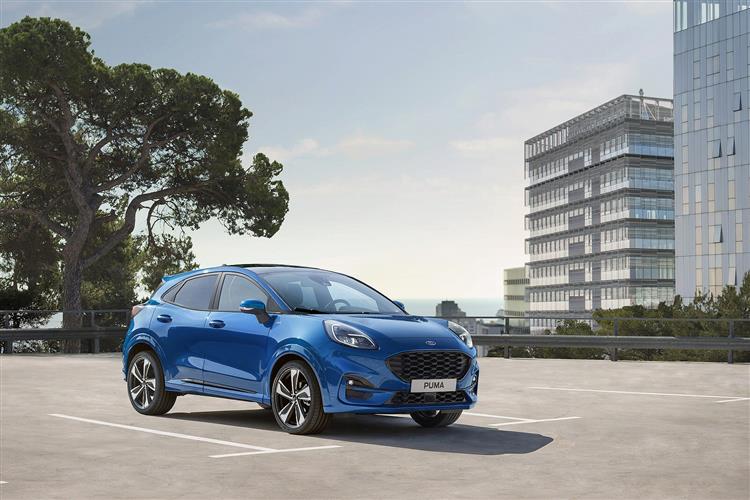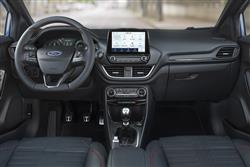PUMA SPORTSWARE (some text hidden) --NONE--
By Jonathan Crouch
Introductionword count: 49
Back in 2019, the Puma model line was launched to serve the smallest, most fashionable end of the SUV segment. Frugal, fun and well connected, it fitted well with the spirit of its time and became a British best seller. But how good is it as a used buy?
Modelsword count: 11
5dr SUV (Petrol - 1.0 EcoBoost, 1.5 EcoBoost, 1.5 TDCi diesel)
Historyword count: 310
You might just remember the original Ford Puma - not the little SUV we look at here but a little coupe made around the turn of the century. By 2019, cars like that just weren't selling any more, so this model line reinvented itself as what Ford called an 'SUV-inspired Crossover'. Like the original Puma, this one was based on Fiesta engineering and was primarily powered by the mild hybrid 1.0-litre EcoBoost petrol engine the Blue Oval brand also used at the time in that supermini. Dynamic changes over the Fiesta included re-tuned suspension, bigger shock absorbers and a wider track. All of which built on the Fiesta's enviably dynamic feel to ensure that this car handled a little more sharply than recently launched direct class competitors of the time like Nissan's Juke, Volkswagen's T-Cross and Renault's Captur. You might well have gathered from this description that this car, launched in late 2019, was a very different thing from Ford's original attempt at a Fiesta-based small SUV, the largely unloved EcoSport, launched in 2014 and updated three years later. That car wasn't really designed for Europe but this one very definitely was, aiming to demonstrate what the Blue Oval brand could really do when it took this important segment seriously. It was good looking, efficient and spacious by class standards, with loads of clever interior touches too. The range was based around a 1.0-litre three cylinder EcoBoost mild hybrid petrol unit. Initially, Ford also offered the option of an entry-level un-electrified 1.0-litre EcoBoost petrol unit and a 1.5-litre TDCi diesel; both powerplants were quickly discontinued. In 2021, the brand introduced the Puma ST, initially launched with the Fiesta ST hot hatch's 200PS 1.5-litre four cylinder engine and manual transmission; a Puma ST automatic was launched in 2022 with a 170PS version of the three cylinder 1.0-litre EcoBoost mild hybrid unit.
What You Getword count: 632
Visually, there's certainly a lot going on here - maybe even a hint of miniature Porsche Macan if you squint a bit. The unusual 'canoe-shaped' headlights are high up on the bonnet (like the first Puma) and Ford reckoned that the beady daytime running lights you get on 'ST-Line' variants were a nod to a more modern Ford coupe, the GT supercar. And from the side? Well most compact crossovers have a 'wedge'-style profile, something the designers here deliberately wanted to avoid. Hence the more distinctive silhouette with its undulating shoulder line, floating A-pillar, an angled crease that flows up from the front wheel arch and the exaggerated rear haunches. All disguising the fact that the bits you can't see come straight from a humble Fiesta. This Puma sits on the same 'Global B' platform as that car and though the suspension bolted to it is pretty bespoke, the under-bonnet stuff is pretty much identical too. Inside, there are certainly lots of Fiesta parts carried over but you get a bespoke digital instrument cluster screen and you sit 60mm higher than you would in that car. Particularly with pricier variants, you might wish that cabin had less of a supermini ambiance, but the designers clearly tried to do what they could to give this interior a special and lifestyle-orientated feel - things like the cool silver trimming for both the gear knob and the (strangely conventional) handbrake. And the 'ST-Line' variant's carbon-style fascia finishing, red highlights around the outer vents and red stitching. The 12.3-inch instrument cluster screen, fitted from ST-Line trim upwards, springs into life when you select one of the driving modes and is almost infinitely customisable with information between the two virtual gauges. Anything this display can't tell you will probably be covered off by the 8.0-litre SYNC3 centre-dash monitor. It offers helpful shortcut 'Audio', 'Phone', 'Navigation', 'Apps' and 'Settings' press selections at the base of the screen and incorporates an excellent quality 7-speaker DAB sound system - which was optionally upgradeable to a 10-speaker B&O premium set-up. All-round visibility could be better, but there are plenty of places to store things and a brilliant standard of media connectivity, with a built-in embedded FordPass Connect WiFi modem, plenty of connectivity ports and a standard wireless charging mat And the rear? Well our hopes weren't especially high here: a Fiesta is, after all, somewhat on the cramped side at the back and despite its lengthier platform, this Crossover isn't much bigger than one of those. But it would make a lot more sense than a supermini as a second family car. True, the small side windows don't help to create much of a roomy feel and if you've lanky teenagers to ferry about, we'd steer you clear of models fitted with the optional panoramic glass roof, which eats into head room. Otherwise though, a couple of six-footers would be comfortable enough, helped by the way they could slide their big size 10s under the seat in front, though there's less leg and knee room than you'd get in segment rivals like the Skoda Kamiq and the Volkswagen T-Roc. Out back, a handsfree powered tailgate was optional, but you don't really need it because the hatch is light to lift and opens to reveal something unusual: a decently-sized boot in a small Ford. This one has a 456-litre capacity - one of the largest in the segment. When you lift the tailgate, the parcel shelf rises out of the way with it, flat against the tailgate glass. Equally neat is the adjustable-height boot floor, beneath which lies this 68-litre recessed well - Ford enthusiastically called it a 'Megabox'- which allows you to carry tall items like electrical equipment upright. Push forward the 60:40-split rear backrest and a 1,216-litre space reveals itself.
To see the full road test text contact us on 0330 0020 227
Pictures (high res disabled)

.jpg)
|
.jpg)
|
.jpg)
| |||
.jpg)
|
.jpg)
|
.jpg)
| |||
.jpg)
|
.jpg)
|
.jpg)
| |||
.jpg)
|

|
Scoring (subset of scores)
Category: Crossover or SUV 4x4s
| Performance | |
| Handling | |
| Comfort | |
| Space | |
| Styling, Build, Value, Equipment, Depreciation, Handling, Insurance and Total scores are available with our full data feed. | |



